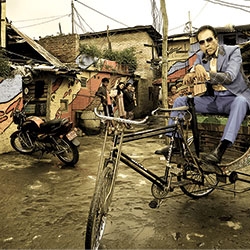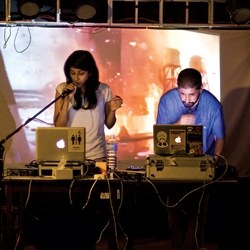This generation will boast of many things; seeing the new millennium, being alive when Eminem blew up, watching Sachin Tendulkar, Austin 3:16, Ducktales and the birth of load shedding. So close we were to having the perfect generation
Let me paint you a picture; friends sitting around a U-shaped bar, shooting the breeze and talking about music. The recording, the music culture today, you know, the works. Someone who looks a lot like me suddenly looks at his watch and notices the time; its 8 pm. A smile spreads across his face as this doppelganger is filled with a blissful thought, “There is electricity at home!” He thinks of all the movies and TV shows and his online football league that needs tending do. He bids adieu to the denizens and when one asks him why the abrupt leave, he pretty much spills the truth unashamedly. As he turns to leave he can hear one of the most recognizable guitarists of Nepal say, “Kasto bhaisakyo hai! Aba batti ko lagi pani ghar chadai farkinu parcha!”
 We have had to live with this monkey on our backs known as load shedding for some time now. The word ‘load shedding’ itself wasn’t as prominent in the 90s or the early 2000s but by the end of the first decade of the 2000s it was on everyone’s lips. Sure, we experienced mild power outages but the problem started really in the year 2008. No-one could have forecasted though the 16 and 20 hours of loadshedding a day the next year in 2009. Dark times, quite literally.
We have had to live with this monkey on our backs known as load shedding for some time now. The word ‘load shedding’ itself wasn’t as prominent in the 90s or the early 2000s but by the end of the first decade of the 2000s it was on everyone’s lips. Sure, we experienced mild power outages but the problem started really in the year 2008. No-one could have forecasted though the 16 and 20 hours of loadshedding a day the next year in 2009. Dark times, quite literally.
It is rather shameful that we have to go through this when the 83,000 MW output capacity of Nepal’s water resources are equivalent to that of the entire North American continent. However, the number 83,000 MW itself has also come into contention with researchers calling it a mere ‘hydro myth’. Governments have changed and while the Maoists led government had “promised” to bank on “the nation’s liquid gold”, nothing really came to fruition. We have lived through a steady and patient 12 hour average for 5 years now and have seen little shift in the dynamic. If nothing, it has taught us not to be too dependent on the basic amenity that is electricity.
When asked, the government so beautifully replies “no rain”. Maybe all those tears shed by students preparing for exams (Fact: SLC exam is not the only exam season) with no light could flip a turbine. But we digress.
Situated in the pockets of Syuchatar lies the much sought after, Load Shedding Station. Makes you wonder why it is situated on the outskirts but then again, you’d want to keep a place like that a little away from people irate from the ungodly hours of no electricity. It is the place where it all happens. By ‘it all’ I mean where a man does his job and takes away all the power from your house. It is a magical place this and a place where access is quite prohibited too. However a little further down town behind a very stereotypical table sits Sher Singh Bhatta, Director of Power Trading Department at Nepal Electricity Authority (NEA) who explains the workings of this station quite clearly. “It is all manual. There is a guy there who does his shift and basically flips a switch that results in a designated group’s power cut.” Bhatta further explains that the machine is pretty elementary and requires staffers who rotate through shifts throughout day and night for monitoring the power outage. “There is nothing too fancy about the machine in general,” Bhatta grins,” but it serves its purpose.” It does indeed, as my phone battery lies half dead at 5%.
But that is not clearly where the story just ends, a certain Mr. Bhattarai, on the condition of animosity, at one of the electricity offices explains the plight of these men. “We have to keep our premises secured,” he says when questioned about all the red tape and no entries I had faced. “It is necessary for our staff and also makes our working much easier.” Strange, didn’t we pay for this building they work in?
Me: “Sir with the FIFA World Cup coming up, will we have any respite from the load shedding?”
Le Sir: “But of course, as it is they are going down every day, and if the monsoon comes early, it will hardly last a few hours.”
I’d take walking on muddy roads if that meant I’d have electricity at home a little longer. So said every Nepali reading this article.
The negative impacts that such rolling blackouts cause are best not mentioned. We know them by heart by now. The late hours you have to get up to charge your phone or mobile, having to do important work in emergency lights and worse of all, coming home after a hard day’s work only to find no electricity at home. No fan in the heat, no TV to relax your mind. It is a sad state of affairs if you start comparing with other places but we have learned to live with it. Then again, what other choice did we have?
It is this callous we have built from years and years of the ill-fated ‘yestai ho’ mentality. It has crippled us psychologically and has made us believe in ourselves a little lesser every day as any sort of agents for change. If we look back into our past, times when we have taken a stand and done something about an injustice, we have seen some sort of reaction from the powers that be. But is load shedding just too big a problem and something that the elected rulers will always have a problem fixing?
Not too long ago, a long bedsheet was laid out while people around it encouraged passersby to sign their names on it. It was a petition to end load shedding once and for all. There was a march a few days later to that signing, but it churned out nothing significant. We are still only at the rain’s mercy and every time it does rain and you get drenched by any chance, you wryly think to ourselves, “At least there will be electricity at home.” Silver linings for the unfortunate are like old buried bones to a dog.
“An important concept we need to understand is that load shedding is worse in bigger cities, not so much in the cities outside,” says Bhatta. “If you ask me personally as to what I can advise to the people who are reading this to do for their electric needs, I’d suggest Solar Energy. It gives back energy, it has become accessible and we must look for other sources of energy as well, and develop them.” A noble thought indeed, with some 900 MegaWatts of hydropower under construction and some concrete agreements with private firms finally coming to fruition, it seems that one can finally dream of a winter where we are not counting the hours down for the light to come back. The agreement with India also sees them bringing in some 200 MW of power for time being and NEA remains confident that they can soon bring a palpable end to this debauchery that has gripped our nation for what feels like decades.
As I collect my thoughts and think of all the silver linings, Sher Singh Bhatta drops one last piece of information, “Also son, the load shedding problem will be over in 3-4 years,” and then he smiles.











